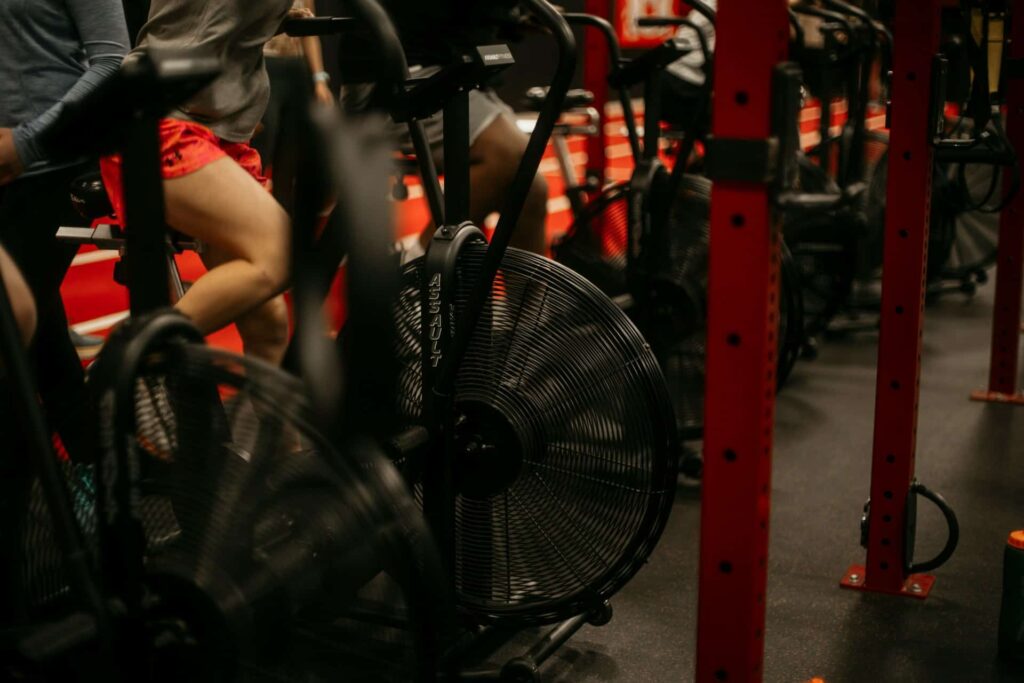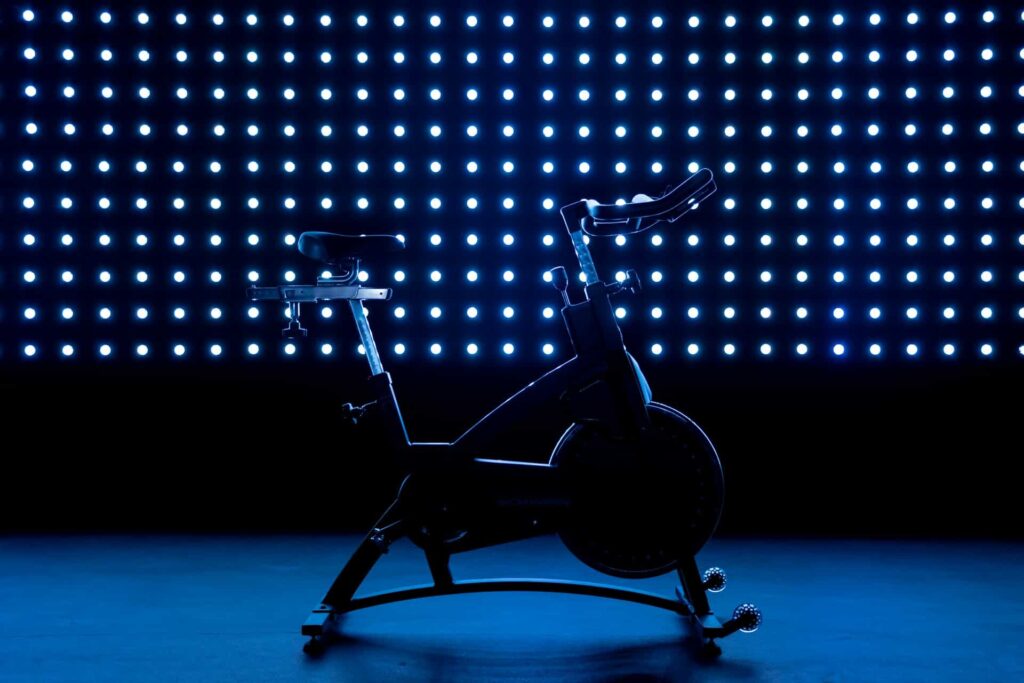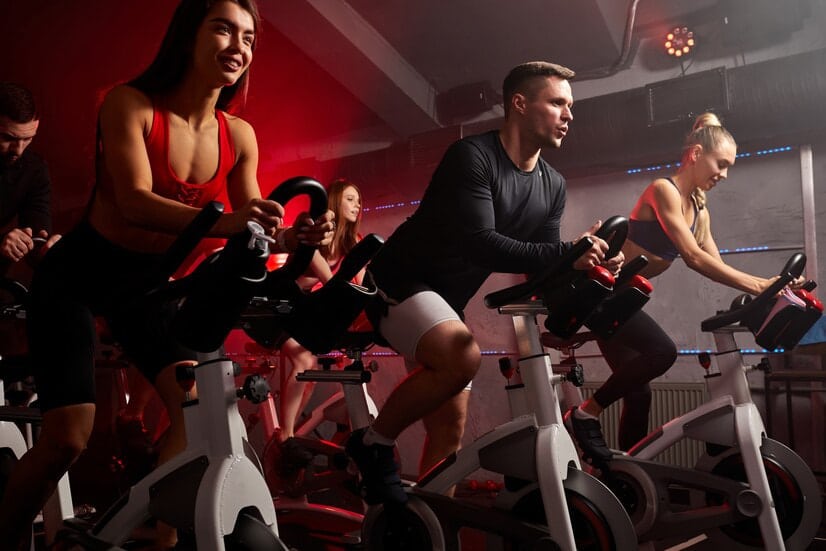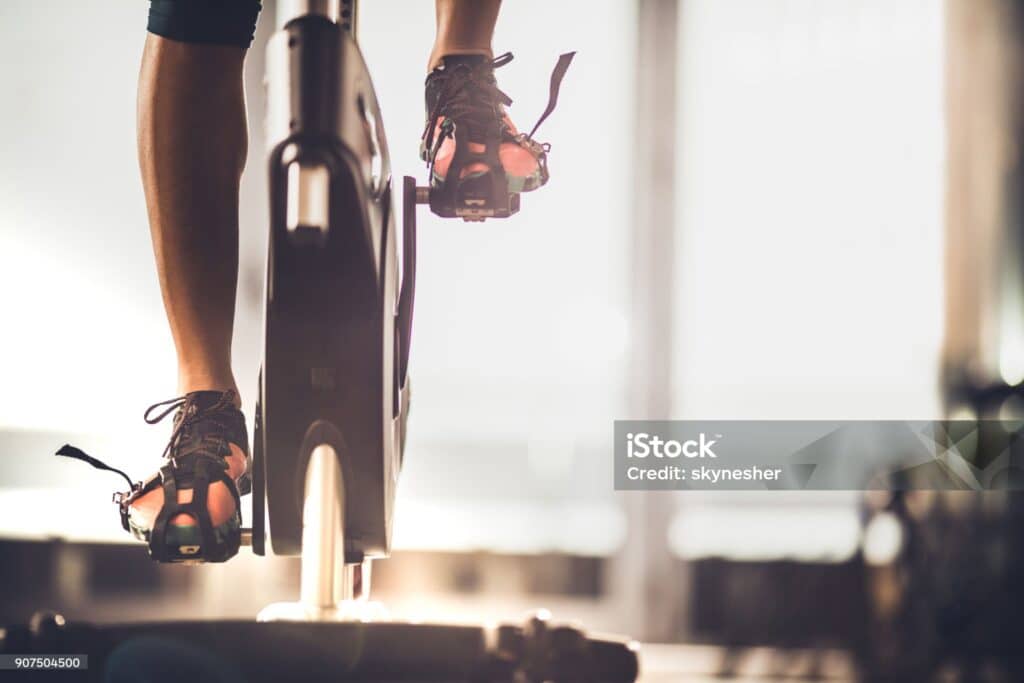
Summary
Welcome » Welcome » Tips for getting started » Exercise bike program to build muscle: the essentials
Exercise bike program to build muscle: the essentials
Are you looking to build muscle effectively with an exercise bike? You are in the right place. This program will guide you step by step to achieve your goals.
Summary
Choice of exercise bike
We offer targeted exercises to strengthen your muscles, burn calories and protect your joints. Whether you are a beginner or intermediate, our exercise bike program plans for building muscle are made for you.
Types of bikes
Upright Bike
The upright bike is the most common model in homes and gyms. Compact and ergonomic, it allows you to pedal in a position similar to that of a traditional bicycle. The back is straight, the pedals are positioned directly under the body, and the natural movements make training comfortable. This type of bike is perfect for those who want simulate a road cycling experience.
Recumbent Bike
The bike recumbent, or semi-recumbent bike and its benefits, offers an alternative with a more relaxed position. Here, the user is in a semi-recumbent position, the back well supported by a large seat and the pedals placed in front of the body. This setup is ideal for those looking to reduce pressure on the back and joints while getting a great cardio workout. The increased comfort allows for longer sessions, ideal for a endurance training.
Tips for choosing: How to choose the right bike for your needs
Evaluate your goals
Before investing in an exercise bike, it is essential to define your goals. If you are looking to improve your general physical condition, the upright bike is an excellent option. For those who prefer a more comfortable workout or have back problems, the recumbent bike is a better alternative.
Consider the available space
The upright bike is generally more compact, perfect for small spaces. The recumbent bike, although more imposing, offers superior comfort for prolonged sessions.
Test before buying
Nothing beats a trial in store. Make sure that the seat is comfortable, that the pedals are accessible and that the console is easy to use. There bike stability and fluidity of pedaling are essential criteria.
Watch Features
More advanced models offer integrated training programs, heart rate monitors, and connectivity options to track your progress via mobile apps. These features can improve your motivation And optimize your sessions.
Budget
Prices vary considerably, from a few hundred to several thousand euros. A mid-range model can often offer excellent value for money, with enough features for a effective training without blowing your budget.
By carefully choosing your exercise bike, you ensure a enjoyable workout And effective, perfectly adapted to your specific needs.

Benefits of training on an exercise bike
Muscle strengthening
Training on an exercise bike is a great way to strengthen your muscles. Contrary to what many people think, this type of exercise is not just limited to the legs. In reality, it uses several muscle groups, thus contributing to the harmonious development of the body.
Glutes
When you pedal, your glutes are constantly working to maintain a stable position and propel the pedals down. By increasing the resistance, you can further intensify this work and further sculpt your gluteal muscles.
Calves
Each pedaling movement uses the calves. For more focused work, try sessions with a higher resistance. This not only strengthens but also tones this part of your legs.
Hamstrings
The hamstrings, located at the back of your thighs, are activated every time you pull the pedals up. This constant effort contributes to their strengthening and toning.
Abdominal strap
Maintaining good posture on the bike works your abdominals. A well-engaged core is essential for stabilize the body and improve the efficiency of each pedal stroke. You can even integrate specific abdominal exercises during your sessions for even more complete work.
Calorie burning
One of the great advantages of training on an exercise bike is its effectiveness for burn calories. Whether you want to lose weight or simply maintain good physical condition, this exercise is ideal.
High Intensity Intervals (HIIT)
To maximize calorie burn, incorporate high-intensity intervals (HIIT) into your routine. This type of training alternates phases of intense effort with periods of recovery. For example, pedal at full throttle for one minute, then recover at a moderate pace for two minutes. Repeat this cycle several times for a short but extremely effective session.
Continuous session at moderate intensity
If intervals aren't your cup of tea, a continuous session at moderate intensity can also be very beneficial. A 45 minute to one hour session at a brisk pace can burn a significant number of calories, thus aiding in weight management.
Low impact
The exercise bike is an exercise low impact, which means it is gentle on the joints. This is a major advantage, especially for those who have knee, hip or back problems.
Reduce the risk of injury
Unlike running, exercise cycling does not put undue stress on the joints. This significantly reduces the risk of repetitive impact injuries. So you can train more often and for longer without pain.
Suitable for all ages and fitness levels
Thanks to its low impact, the exercise bike is suitable for everyone, regardless of age or fitness level. Whether you are a beginner or an experienced athlete, you can adjust the intensity of your session according to your abilities and your goals.
Workout plan for beginners
Intervals for adaptation
For those who are starting out with the exercise bike, it is essential to start with a adapted training plan. Intervals are a great method to gradually acclimate to exercise while achieving effective results.
Dynamic warm-up
Start each session with a dynamic warm-up. Cycle at a light intensity for 5 to 10 minutes. This gradually increases your heart rate and prepares your muscles for exercise. You can also include some mobility moves for the legs and hips.
Interval sets
For beginners, intervals are particularly recommended. Here is an example of a typical session:
- 1 minute of moderate effort : Pedal at approximately 65 % from your maximum heart rate. You should feel your heart beating faster, but still be able to speak.
- 2 minutes of light recovery : Reduce the intensity to recover. Pedal slowly, making sure to breathe well.
Repeat this cycle 5 to 6 times for a total session of 15 to 18 minutes of intervals. This allows your body to gradually adapt to the effort without too much stress.
Cool down and stretch
End each session with a 5 to 10 minute cool down, pedaling at a very light pace. This helps to reduce the heart rate gradually and avoid muscle aches. Next, perform targeted stretches for your legs, hips and back. Stretching allows you to prevent muscle tension and improve your flexibility.
Tips for progress
Gradual increase in intensity
After a few weeks of this plan, you can gradually increase the intensity of your sessions. For example, reduce the recovery time to 1 minute and increase the duration of moderate effort to 2 minutes. This allows to continue to progress without overloading your body.
Vary the sessions
To avoid monotony and maintain your motivation, vary your sessions. Alternate interval sessions with continuous sessions at moderate intensity. You can also adjust the resistance of the bike to work your muscles differently.
Listen to your body
It is crucial to listen to your body and not force yourself if you experience excessive pain or fatigue. Take rest days to allow your muscles to recover. A balance between training and recovery is essential for sustainable progress.
Track your progress
Use a tracking app or training log to record your sessions, how you feel and your progress. This will help you stay motivated and adjust your program according to your goals.
Training plan for intermediates
Variety of training styles
For those who already have some experience with an exercise bike, it is important to vary training styles to continue to progress and avoid monotony. Two particularly effective training styles are LISS and HIIT.
LISS (Moderate Intensity Cardio)
LISS, or Low-Intensity Steady State, consists of a cardio workout at constant but moderate intensity. This type of exercise is ideal for improving cardiovascular endurance and burn calories continuously.
- Duration : 45 to 60 minutes.
- Intensity : Maintain a stable heart rate, around 60-70 % of your maximum.
- Benefits : Improved endurance, calorie burning, active recovery.
HIIT (High Intensity Training)
HIIT, or High-Intensity Interval Training, alternates periods of intense effort with periods of recovery. This style is excellent for improve general physical condition, burn calories And strengthen muscles in less time.
- Session structure :
- 30 seconds to 1 minute of intense effort (80-90 % of your maximum heart rate).
- 1 to 2 minutes of active recovery at light intensity.
- Total duration : 20 to 30 minutes.
- Benefits : Rapid improvement in physical condition, high calorie expenditure, optimization of training time.
Distance/time
For those who want to focus on specific distance or time goals, here are some suggestions for performance-based workouts.
Distance-based training
Set distance goals to achieve within a certain time frame. For example, try running 10 kilometers in 30 minutes. This type of goal motivates you to maintain a good pace throughout the session.
Time-based training
If you prefer to focus on the duration of the effort rather than the distance, set time goals. For example, ride at a moderate intensity for 60 minutes without interruption. This method is ideal for increase endurance and test your mental and physical resistance.
Combination of the two
For a more complete challenge, combine distance and time goals. For example, try to run 20 kilometers in less than 50 minutes. This pushes you to improve both your speed and your endurance.
Tips for intermediaries
Incorporate resistance exercises
To increase the difficulty of your sessions, play with the resistance of your bike. The higher the resistance, the harder your muscles will have to work. This allows to strengthen your legs and improve your overall strength.
Performance monitoring
Use apps or performance monitors to track your progress. Note your times, distances, and feelings after each session. This helps you stay motivated and adjust your training plan based on your progress.
Listen to your body
Even as an intermediary, it's crucial to listen to your body. Take rest days if necessary and make sure you recover well between intense sessions. A good balance between training and recovery is essential to avoid injury and maximize gains.
Exercises to build muscle
Position on the bike
There position on the bike plays a crucial role in the effectiveness of your weight training sessions. Here are the different positions you can adopt to maximize muscle work.
Seated
The seated position is the most common and most comfortable. For optimal muscle work, maintain an upright posture, engage your core and make sure your knees are in line with your feet. This position mainly calls for quadriceps, THE hamstrings and the glutes.
Standing
Pedaling while standing increases the intensity of the exercise and puts more strain on the muscles. This position is ideal for strengthening the glutes and the calves, because it requires more strength to maintain stability and rhythm. Make sure to distribute your weight evenly between your legs and keep your core engaged to avoid lower back strain.
Variable resistance
Playing with the resistance of the bike is essential to increase the workload on your muscles. A high resistance imitates hills and climbs, intensely engaging the quadriceps, calves and glutes. Start at a moderate resistance and gradually increase to stimulate muscle growth.
Muscle groups used
The exercise bike can be used to specifically target different muscle groups. Here's how to optimize each session for complete muscle work.
Glutes
To work your glutes, adopt a standing position and increase the resistance. You can also do some backward pedaling sessions, which puts even more strain on this area. Incorporate intervals where you pedal standing for 1 to 2 minutes, followed by seated recovery periods.
Calves
The calves are activated with each pedal stroke. For more targeted work, increase the resistance and focus on the pushing and pulling phase. You can also try pedaling with just your toes to further isolate the calves.
Hamstrings
The hamstrings work in tandem with the quadriceps. To work them more, increase the pace while maintaining moderate resistance. Cycling while seated with high resistance can also help strengthen these muscles.
Abdominal strap
Even though the exercise bike is primarily a lower body exercise, it is possible to strengthen your core by maintaining good posture. Contract your abdominals throughout the session to stabilize your core. You can also incorporate specific movements, such as trunk rotations, while pedaling at a moderate intensity.
Example exercises
Pedaling while standing
This exercise is excellent for the glutes and calves. Alternate between periods of 1 to 2 minutes standing and periods of seated recovery. Increase the resistance to intensify the effort.
Pedaling with high resistance
To work the calves and hamstrings, increase the resistance of the bike. Focus on pushing down and pulling up. Maintain this resistance for 5 to 10 minutes for deep work.
Work on the abdominal strap
Engage your abs throughout the session. For more focused work, try doing trunk rotations every minute for 10 seconds while pedaling. This helps strengthen the obliques and stabilize the core.

Conclusion
The exercise bike is ideal for building muscle. It offers varied benefits: muscle strengthening, calorie burning, and low impact on the joints. By following appropriate plans, you can progress effectively.
For beginners, adaptation intervals are perfect. Intermediates will benefit from the variety of training styles and distance or time goals. Exercises targeted at the glutes, calves, hamstrings and abdominals optimize muscle strengthening.
Strengthen your muscles with Space
Discover SPACE for an immersive 45-minute session in a subdued atmosphere, illuminated by captivating light shows. Immerse yourself in dynamic playlists and motivating choreographies.
Three class formats are available to push you to your limits: Basic Ride, Rhythm Ride, and Power Ride. Each class targets specific muscle groups like arms, legs, and abs, while improving your cardiovascular endurance and strength.
Details of our sessions:
- Rhythm Ride : A focus on 80% for cardio and 20% for muscle strengthening.
- Power Ride : A perfect balance with 50% cardio and 50% strength training, requiring your total commitment.
- Basic Ride : A 30-minute introduction to equipment, rhythms, and essential movements.
Read also
RPM combien de fois par semaine : Guide pour optimiser vos séances
Vélo d’appartement bienfaits : pourquoi l’adopter dès maintenant ?
Follow us
on instagram
To follow all our news,
take advantage of our tutorials and participate
in our many contests.
Breaking news!
Receive our newsletter.





